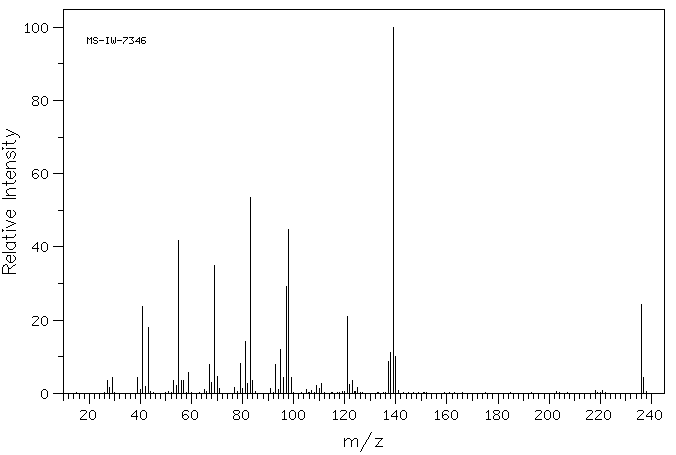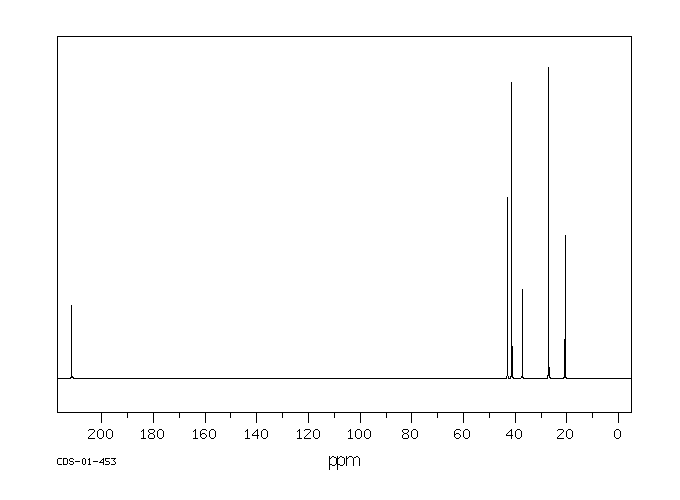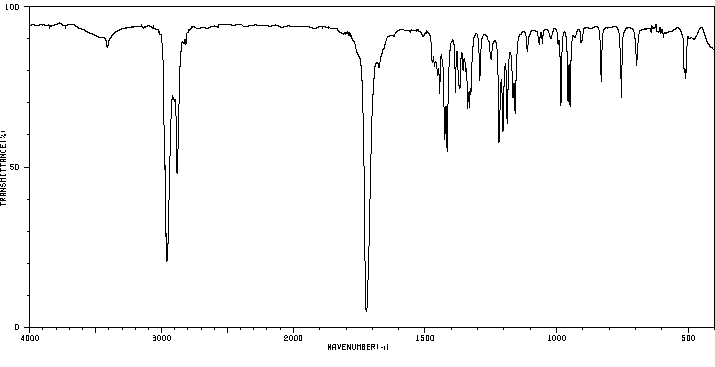2,2-二(4-环己酮基)丙烷 | 7418-16-8
中文名称
2,2-二(4-环己酮基)丙烷
中文别名
4,4'-异亚丙基双(环己酮);2,2-双(4-环己酮基)丙烷;2,2'-双(4-氧代环己基)丙烷;2,2-二(4-羰基环己)丙烷
英文名称
2,2-bis(4-oxocyclohexyl)propane
英文别名
4-[2-(4-oxocyclohexyl)propan-2-yl]cyclohexan-1-one
CAS
7418-16-8
化学式
C15H24O2
mdl
MFCD00191618
分子量
236.354
InChiKey
HAWVCXABNZBPED-UHFFFAOYSA-N
BEILSTEIN
——
EINECS
——
-
物化性质
-
计算性质
-
ADMET
-
安全信息
-
SDS
-
制备方法与用途
-
上下游信息
-
文献信息
-
表征谱图
-
同类化合物
-
相关功能分类
-
相关结构分类
物化性质
-
熔点:164 °C
-
溶解度:溶于氯仿
-
稳定性/保质期:
如果按照规格使用和储存,则不会分解。
计算性质
-
辛醇/水分配系数(LogP):2.3
-
重原子数:17
-
可旋转键数:2
-
环数:2.0
-
sp3杂化的碳原子比例:0.866
-
拓扑面积:34.1
-
氢给体数:0
-
氢受体数:2
安全信息
-
海关编码:2914299000
-
储存条件:密封在阴凉干燥的环境中。
SDS
2,2-Bis(4-oxocyclohexyl)propane Revision number: 1
SAFETY DATA SHEET
Section 1. BASE INFORMATION
Product name: 2,2-Bis(4-oxocyclohexyl)propane
Revision number: 1
Section 2. HAZARDS IDENTIFICATION
Classification of the GHS
PHYSICAL HAZARDS Not classified
HEALTH HAZARDS Not classified
Not classified
ENVIRONMENTAL HAZARDS
GHS label elements
None
Pictograms or hazard symbols
Signal word No signal word
None
Hazard statement
Precautionary statements None
Section 3. COMPOSITION/INFORMATION ON INGREDIENTS
Substance/mixture: Substance
Component(s): 2,2-Bis(4-oxocyclohexyl)propane
Percent: >95.0%(GC)
CAS Number: 7418-16-8
Synonyms: 4,4'-Isopropylidenebis(cyclohexanone)
Chemical Formula: C15H24O2
Section 4. FIRST AID MEASURES
Inhalation: Remove victim to fresh air and keep at rest in a position comfortable for breathing.
Get medical advice/attention if you feel unwell.
Skin contact: Remove/Take off immediately all contaminated clothing. Rinse skin with
water/shower. If skin irritation or rash occurs: Get medical advice/attention.
Eye contact: Rinse cautiously with water for several minutes. Remove contact lenses, if present
and easy to do. Continue rinsing. If eye irritation persists: Get medical
advice/attention.
Ingestion: Get medical advice/attention if you feel unwell. Rinse mouth.
A rescuer should wear personal protective equipment, such as rubber gloves and air-
Protection of first-aiders:
tight goggles.
Section 5. FIRE-FIGHTING MEASURES
Suitable extinguishing Dry chemical, foam, water spray, carbon dioxide.
media:
Specific methods: Fire-extinguishing work is done from the windward and the suitable fire-extinguishing
method according to the surrounding situation is used. Uninvolved persons should
evacuate to a safe place. In case of fire in the surroundings: Remove movable
containers if safe to do so.
2,2-Bis(4-oxocyclohexyl)propane
Section 5. FIRE-FIGHTING MEASURES
Special protective When extinguishing fire, be sure to wear personal protective equipment.
equipment for firefighters:
Section 6. ACCIDENTAL RELEASE MEASURES
Personal precautions, Use personal protective equipment. Keep people away from and upwind of spill/leak.
protective equipment and Entry to non-involved personnel should be controlled around the leakage area by
emergency procedures: roping off, etc.
Environmental precautions: Prevent product from entering drains.
Methods and materials for Sweep dust to collect it into an airtight container, taking care not to disperse it.
containment and cleaning Adhered or collected material should be promptly disposed of, in accordance with
up: appropriate laws and regulations.
Section 7. HANDLING AND STORAGE
Handling
Handling is performed in a well ventilated place. Wear suitable protective equipment.
Technical measures:
Prevent dispersion of dust. Wash hands and face thoroughly after handling.
Use a local exhaust if dust or aerosol will be generated.
Advice on safe handling: Avoid contact with skin, eyes and clothing.
Storage
Storage conditions: Keep container tightly closed. Store in a cool and dark place.
Store away from incompatible materials such as oxidizing agents.
Packaging material: Law is followed.
Section 8. EXPOSURE CONTROLS / PERSONAL PROTECTION
Engineering controls: Install a closed system or local exhaust as possible so that workers should not be
exposed directly. Also install safety shower and eye bath.
Personal protective equipment
Respiratory protection: Dust respirator. Follow local and national regulations.
Protective gloves.
Hand protection:
Eye protection: Safety glasses. A face-shield, if the situation requires.
Skin and body protection: Protective clothing. Protective boots, if the situation requires.
Section 9. PHYSICAL AND CHEMICAL PROPERTIES
Physical state (20°C): Solid
Form: crystal - powder
White - Slightly pale yellow
Color:
Odor: No data available
pH: No data available
Melting point/freezing point:164 °C
Boiling Point/Range: No data available
Flash Point: No data available
Explosive limits
Lower: No data available
No data available
Upper:
Density: No data available
Soluble in : Chloroform
Solubility:
Section 10. STABILITY AND REACTIVITY
Stability: Stable under proper conditions.
Reactivity: No special reactivity has been reported.
Incompartible materials: oxidizing agents
Hazardous Decomposition Carbon monoxide, Carbon dioxide
Products:
Section 11. TOXICOLOGICAL INFORMATION
Acute Toxicity: No data available
2,2-Bis(4-oxocyclohexyl)propane
Section 11. TOXICOLOGICAL INFORMATION
Skin corrosion/irritation: No data available
Serious eye No data available
damage/irritation:
Germ cell mutagenicity: No data available
Carcinogenicity:
No data available
IARC =
NTP = No data available
No data available
Reproductive toxicity:
Section 12. ECOLOGICAL INFORMATION
Ecotoxicity:
Fish: No data available
Crustacea: No data available
Algae: No data available
Persistence / degradability: No data available
Bioaccumulative No data available
potential(BCF):
Mobillity in soil
log Pow: No data available
Soil adsorption (Koc): No data available
Henry's Law No data available
constant(PaM3/mol):
Section 13. DISPOSAL CONSIDERATIONS
Recycle to process, if possible. Consult your local regional authorities. You may be able to dissolve or mix material
with a combustible solvent and burn in a chemical incinerator equipped with an afterburner and scrubber system.
Observe all federal, state and local regulations when disposing of the substance.
Section 14. TRANSPORT INFORMATION
Hazards Class: Does not correspond to the classification standard of the United Nations
UN-No: Not Listed
Section 15. REGULATORY INFORMATION
Safe management ordinance of dangerous chemical product (State Council announces on January 26,
2002): Safe use and production, the storage of a dangerous chemical, transport, loading and unloading were
prescribed.
SECTION 16 - ADDITIONAL INFORMATION
N/A
SAFETY DATA SHEET
Section 1. BASE INFORMATION
Product name: 2,2-Bis(4-oxocyclohexyl)propane
Revision number: 1
Section 2. HAZARDS IDENTIFICATION
Classification of the GHS
PHYSICAL HAZARDS Not classified
HEALTH HAZARDS Not classified
Not classified
ENVIRONMENTAL HAZARDS
GHS label elements
None
Pictograms or hazard symbols
Signal word No signal word
None
Hazard statement
Precautionary statements None
Section 3. COMPOSITION/INFORMATION ON INGREDIENTS
Substance/mixture: Substance
Component(s): 2,2-Bis(4-oxocyclohexyl)propane
Percent: >95.0%(GC)
CAS Number: 7418-16-8
Synonyms: 4,4'-Isopropylidenebis(cyclohexanone)
Chemical Formula: C15H24O2
Section 4. FIRST AID MEASURES
Inhalation: Remove victim to fresh air and keep at rest in a position comfortable for breathing.
Get medical advice/attention if you feel unwell.
Skin contact: Remove/Take off immediately all contaminated clothing. Rinse skin with
water/shower. If skin irritation or rash occurs: Get medical advice/attention.
Eye contact: Rinse cautiously with water for several minutes. Remove contact lenses, if present
and easy to do. Continue rinsing. If eye irritation persists: Get medical
advice/attention.
Ingestion: Get medical advice/attention if you feel unwell. Rinse mouth.
A rescuer should wear personal protective equipment, such as rubber gloves and air-
Protection of first-aiders:
tight goggles.
Section 5. FIRE-FIGHTING MEASURES
Suitable extinguishing Dry chemical, foam, water spray, carbon dioxide.
media:
Specific methods: Fire-extinguishing work is done from the windward and the suitable fire-extinguishing
method according to the surrounding situation is used. Uninvolved persons should
evacuate to a safe place. In case of fire in the surroundings: Remove movable
containers if safe to do so.
2,2-Bis(4-oxocyclohexyl)propane
Section 5. FIRE-FIGHTING MEASURES
Special protective When extinguishing fire, be sure to wear personal protective equipment.
equipment for firefighters:
Section 6. ACCIDENTAL RELEASE MEASURES
Personal precautions, Use personal protective equipment. Keep people away from and upwind of spill/leak.
protective equipment and Entry to non-involved personnel should be controlled around the leakage area by
emergency procedures: roping off, etc.
Environmental precautions: Prevent product from entering drains.
Methods and materials for Sweep dust to collect it into an airtight container, taking care not to disperse it.
containment and cleaning Adhered or collected material should be promptly disposed of, in accordance with
up: appropriate laws and regulations.
Section 7. HANDLING AND STORAGE
Handling
Handling is performed in a well ventilated place. Wear suitable protective equipment.
Technical measures:
Prevent dispersion of dust. Wash hands and face thoroughly after handling.
Use a local exhaust if dust or aerosol will be generated.
Advice on safe handling: Avoid contact with skin, eyes and clothing.
Storage
Storage conditions: Keep container tightly closed. Store in a cool and dark place.
Store away from incompatible materials such as oxidizing agents.
Packaging material: Law is followed.
Section 8. EXPOSURE CONTROLS / PERSONAL PROTECTION
Engineering controls: Install a closed system or local exhaust as possible so that workers should not be
exposed directly. Also install safety shower and eye bath.
Personal protective equipment
Respiratory protection: Dust respirator. Follow local and national regulations.
Protective gloves.
Hand protection:
Eye protection: Safety glasses. A face-shield, if the situation requires.
Skin and body protection: Protective clothing. Protective boots, if the situation requires.
Section 9. PHYSICAL AND CHEMICAL PROPERTIES
Physical state (20°C): Solid
Form: crystal - powder
White - Slightly pale yellow
Color:
Odor: No data available
pH: No data available
Melting point/freezing point:164 °C
Boiling Point/Range: No data available
Flash Point: No data available
Explosive limits
Lower: No data available
No data available
Upper:
Density: No data available
Soluble in : Chloroform
Solubility:
Section 10. STABILITY AND REACTIVITY
Stability: Stable under proper conditions.
Reactivity: No special reactivity has been reported.
Incompartible materials: oxidizing agents
Hazardous Decomposition Carbon monoxide, Carbon dioxide
Products:
Section 11. TOXICOLOGICAL INFORMATION
Acute Toxicity: No data available
2,2-Bis(4-oxocyclohexyl)propane
Section 11. TOXICOLOGICAL INFORMATION
Skin corrosion/irritation: No data available
Serious eye No data available
damage/irritation:
Germ cell mutagenicity: No data available
Carcinogenicity:
No data available
IARC =
NTP = No data available
No data available
Reproductive toxicity:
Section 12. ECOLOGICAL INFORMATION
Ecotoxicity:
Fish: No data available
Crustacea: No data available
Algae: No data available
Persistence / degradability: No data available
Bioaccumulative No data available
potential(BCF):
Mobillity in soil
log Pow: No data available
Soil adsorption (Koc): No data available
Henry's Law No data available
constant(PaM3/mol):
Section 13. DISPOSAL CONSIDERATIONS
Recycle to process, if possible. Consult your local regional authorities. You may be able to dissolve or mix material
with a combustible solvent and burn in a chemical incinerator equipped with an afterburner and scrubber system.
Observe all federal, state and local regulations when disposing of the substance.
Section 14. TRANSPORT INFORMATION
Hazards Class: Does not correspond to the classification standard of the United Nations
UN-No: Not Listed
Section 15. REGULATORY INFORMATION
Safe management ordinance of dangerous chemical product (State Council announces on January 26,
2002): Safe use and production, the storage of a dangerous chemical, transport, loading and unloading were
prescribed.
SECTION 16 - ADDITIONAL INFORMATION
N/A
上下游信息
-
上游原料
中文名称 英文名称 CAS号 化学式 分子量 氢化双酚A 4,4'-isopropylidenedicyclohexanol 80-04-6 C15H28O2 240.386
反应信息
-
作为反应物:描述:2,2-二(4-环己酮基)丙烷 在 盐酸 、 sodium azide 作用下, 生成 5,5'-(1-methyl-ethane-1,1-diyl)-bis-azepan-2-one参考文献:名称:DE939811摘要:公开号:
-
作为产物:描述:参考文献:名称:双酚A加氢产物的异构体。2,2-双-(4-羟基环己基)丙烷的三种异构体和2-(4-羟基环己基)-2-(对羟基苯基)丙烷的两种异构体的分离和构型摘要:双酚 A (I) 在 Raney 镍 (W-1) 和 Urushibara 镍 A 和 B 上的氢化已经进行,并且 2,2-双(4-羟基环己基)丙烷 (II) 的三种立体异构体和 2-( 4-羟基环己基)-2-(对羟基苯基)丙烷(III)已从产物中分离出来。II 异构体、cis-cis (mp 174–175°C)、cis-trans (164–165.5°C) 和 trans-trans (188–189°C) 以及 III 异构体的构型和优选构象、顺式 (159–161°C) 和反式 (150.5–151.5°C) 已通过红外和核磁共振光谱、钠转化为稳定异构体和其他方法确定。当与纯化的甲醇一起加热时,由 II 的异构混合物的三氧化铬氧化制备的 2,2-双(4-酮环己基)丙烷得到 2,2-双(4,4-二甲氧基环己基)丙烷,mp 140。5–141.5°C。IIIt从苯中重结晶得到IIItDOI:10.1246/bcsj.39.2194
文献信息
-
新規な脂環式ジオール化合物
-
Ruthenium-on-Carbon-Catalyzed Facile Solvent-Free Oxidation of Alcohols: Efficient Progress under Solid–Solid (Liquid)–Gas Conditions作者:Kwihwan Park、Jing Jiang、Tsuyoshi Yamada、Hironao SajikiDOI:10.1248/cpb.c21-00749日期:2021.12.1solvent-free oxidation of alcohols, which proceeds efficiently under solid–solid (liquid)–gas conditions, was developed. Various primary and secondary alcohols were transformed to corresponding aldehydes and ketones in moderate to excellent isolated yields by simply stirring in the presence of 10% Ru/C under air or oxygen conditions. The solvent-free oxidation reactions proceeded efficiently regardless of the
-
Catalyst comprising a cyclic imide compound and process for producing organic compounds using the catalyst申请人:——公开号:US20020128149A1公开(公告)日:2002-09-12A catalyst includes a cyclic imide compound having an N-substituted cyclic imide skeleton represented by following Formula (I): 1 wherein X is an oxygen atom or a hydroxyl group, and having a solubility parameter of less than or equal to 26 [(MPa) ½ ] as determined by Fedors method. The catalyst may further comprise a metallic compound. By allowing (A) a compound capable of forming a radical to react with (B) a radical scavenging compound in the presence of the catalyst, an addition or substitution reaction product between the compound (A) and the compound (B) or a derivative thereof can be obtained.
-
A New Synthetic Route to 3,4-Bridged 1,6,6aλ4-Trithiapentalenes作者:Wei Zhang、Yewande HenryDOI:10.1055/s-2001-15160日期:——A new synthetic route to 3,4-bridged 1,6,6aλ 4-trithiapentalenes is developed based on reactions of cyclic ketones with Bredereck's reagent followed by thiolation of keto dienamines with phosphorus pentasulfide or Lawesson's reagent.
-
METHOD FOR PRODUCING OXIDE申请人:DAICEL CORPORATION公开号:US20160159722A1公开(公告)日:2016-06-09Provided is a method of oxidizing a substrate with excellent oxidizing power to yield a corresponding oxide. The method can employ a commercially available imide compound as intact as a catalyst and can produce the oxide in a high yield under mild conditions. A method for producing an oxide according to the present invention includes performing oxidation of a substrate in the presence of oxygen and ozone under catalysis of an imide compound to yield a corresponding oxide. The imide compound has a cyclic imide skeleton represented by Formula (I). In the formula, n is selected from 0 and 1; and X is selected from an oxygen atom and an —OR group, where R is selected from hydrogen and a hydroxy-protecting group.
表征谱图
-
氢谱1HNMR
-
质谱MS
-
碳谱13CNMR
-
红外IR
-
拉曼Raman
-
峰位数据
-
峰位匹配
-
表征信息
同类化合物
(反式)-4-壬烯醛
(s)-2,3-二羟基丙酸甲酯
([1-(甲氧基甲基)-1H-1,2,4-三唑-5-基](苯基)甲酮)
(Z)-4-辛烯醛
(S)-氨基甲酸酯β-D-O-葡糖醛酸
(S)-3-(((2,2-二氟-1-羟基-7-(甲基磺酰基)-2,3-二氢-1H-茚满-4-基)氧基)-5-氟苄腈
(R)-氨基甲酸酯β-D-O-葡糖醛酸
(5,5-二甲基-2-(哌啶-2-基)环己烷-1,3-二酮)
(2,5-二氟苯基)-4-哌啶基-甲酮
龙胆苦苷
龙胆二糖甲乙酮氰醇(P)
龙胆二糖丙酮氰醇(P)
龙胆三糖
龙涎酮
齐罗硅酮
齐留通beta-D-葡糖苷酸
鼠李糖
黑芥子苷单钾盐
黑海棉酸钠盐
黑木金合欢素
黑曲霉三糖
黑介子苷
黄尿酸8-O-葡糖苷
麻西那霉素II
麦迪霉素
麦芽糖脎
麦芽糖基海藻糖
麦芽糖1-磷酸酯
麦芽糖
麦芽四糖醇
麦芽四糖
麦芽十糖
麦芽六糖
麦芽五糖水合物
麦芽五糖
麦芽五糖
麦芽五糖
麦芽三糖醇
麦芽三糖
麦芽三糖
麦芽三塘水合
麦芽七糖水合物
麦芽七糖
麦法朵
麦可酚酸-酰基-Β-D-葡糖苷酸
麦利查咪
麝香酮
鹤草酚
鸢尾酚酮 3-C-beta-D-吡喃葡萄糖苷
鸡矢藤苷










